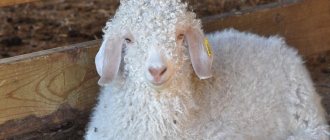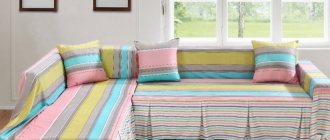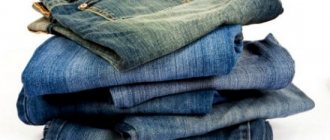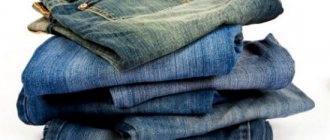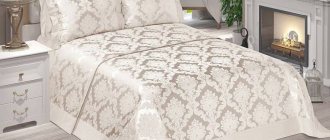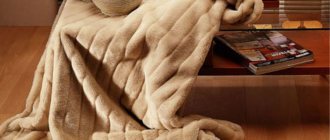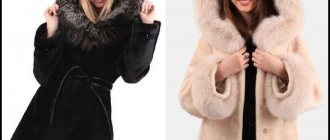The purpose of the bedspread in the bedroom
First of all, it is quite obvious that the bedspread is simply beautiful. It transforms the interior, makes the bedroom more comfortable and the bed more luxurious. In addition, the bedspread performs a lot of useful functions:
- gives the bed a neater appearance, hiding bed linen from view,
- protects bed linen from dirt and dust,
- allows children to lie on the bed and play without creasing or dirtying the bed linen,
- a blanket hanging over the edges can disguise a very thick mattress, not very aesthetic legs or storage space under the bed,
- complements the bedroom interior, gives it integrity, helps set the mood for relaxation,
- many types of bedspreads can be used as a light blanket during hot periods.
A beautiful bedspread with an original pattern can become the highlight of a bedroom interior, emphasizing the refined taste of the owners.
Right size
Immediately before purchasing, you need to decide on the size. The size range of modern products has a fairly wide range, in addition, there is no single standard, so it is best to determine the most optimal frames.
To correctly calculate all the values, it is necessary to measure certain parameters of the bed:
- height;
- width;
- length.
All parameters are determined taking into account the dimensions of the mattress. In addition, the distance over which a product with long pile can hang is taken into account. If you need to purchase a cotton product for a bed 1.5 meters wide and it should hang 0.3 meters on both sides, then the width of the bedspread is calculated as follows:
1.5 m + 0.3 m + 0.3 m + 0.1 m (reserve) = 2.2 m.
As a result of the calculations, we obtain the optimal width limits. This is approximately 2 - 2.2 m.
To determine the length, in addition to standard values, the presence or absence of a backrest at the head or foot of the bed is taken into account. If the sleeping bed has no backs, then the length is calculated in the same way as the width. For a bed with two headboards, the length of the long-pile bedspread should be equal to the bed or slightly longer.
For a standard bed 1.6 m by 2.0 m with one headboard, you need to choose a cotton bedspread with dimensions of 2.0 m by 2.25 m; 2.10 m by 2.30 m; 2.20 m by 2.35 m.
How to calculate the size of a bedspread
Features of bedspreads
A bedspread is not a mandatory element, and many people successfully manage without bedspreads. But at the same time, it is a very convenient and useful item that helps decorate the bedroom and extends the life of furniture, bedding and other accessories, helps maintain order and save energy.
By changing the bedspread, you can significantly update the decor in the bedroom, shifting the aesthetic emphasis, shifting the design color palette to a cold or warm area, making the room lighter or darker, depending on the chosen appearance of the bedspread.
Bedspreads are most useful in the bedroom, in the nursery, but you can’t do without them in the living room either - for example, a bedspread can better protect the fabric upholstery of a sofa from fading, greasing, abrasion, staining and other damage.
When purchasing a bedspread, you only need to determine a place for it where it will be stored at night while the bed is dismantled. It is convenient to have 2 bedspreads so that the bed is not left without protection during the washing or cleaning period, or to quickly change the appearance of the bedroom, but however, in many cases you can do without it.
Kinds
The material of cotton bedspreads may seem too simple and unobtrusive. This is not true - there is an impressive variety of types of these products on the market. Stylish, cozy bedspreads can please the most picky customers.
One of the most popular types of cotton bedspreads is a quilted cape, created from natural raw materials without impurities. A bed or sofa covered with it looks soft and adds volume. The material gives the room the required coziness and introduces additional notes of comfort into the space.
Bedspreads made in the patchwork style are fashionable today. Their mere presence in the room brings style and brightness, even if the original interior is quite modest.
Patchwork, that is, sewing from scraps, has come to this day from ancient times - the technique was created by our great-grandmothers.
Its basis is a harmonious combination of small woven elements, precisely selected according to the pattern, shade, and texture of the material. A cotton blanket of this type, placed on a bed or sofa, will turn into a bright accent even in a room with a small amount of not the most expensive furniture.
Furniture covered with a thin waffle cotton blanket, a “beach” option, emphasizes romance. This blanket is also great for covering yourself in hot weather.
Another type is natural cotton bedspreads with interesting embroidery. Suitable for rooms decorated in the spirit of timeless classics.
Those who prefer to create things with their own hands can make a lace knitted cape from cotton threads. There are no restrictions in this matter. The result depends on the imagination, skills, and patience of the person doing it.
You can create a unique design throughout the room by adding knitted pillows, rugs, and furniture covers.
Naturally, items made from natural cotton or sateen are the most environmentally friendly. These bedspreads are more expensive than options that contain synthetic fibers.
Types of cotton bedspreads based on environmental friendliness of the material:
- The most expensive models are velor or jacquard blankets made of 100% cotton. There is no need to be upset, realizing that there is not yet enough money to purchase accessories of this type. If no one in the family is allergic to synthetic fabrics, you should pay attention to bedspreads with a mixed composition. They have many advantages, in some aspects they are even better than all-natural products.
- The product is made from cotton and acrylic. This material has many of the properties of natural raw materials; woven acrylic threads make the bedspread very durable. Things made of cotton and acrylic are warm, do not lose color when exposed to sunlight, do not wrinkle, and do not change size due to washing. The cape retains its original shape and appearance.
- Popular models are a combination of cotton and polyester. These bedspreads are distinguished by increased wear resistance. They do not require complex care. No sensitivity to sunlight. Blankets dry quickly after washing.
Method of making a bedspread
Production technology affects both the properties and the overall appearance of the bedspread, so it is important to understand what type of bedspread is best suited for your bedroom.
Sewn bedspreads are the most popular and varied. For their manufacture, a variety of fabrics are used, from satin and velvet to tapestry, and even non-woven materials - leather and fur. There are an innumerable variety of colors, patterns and types of finishing - stitching, lace trim, embroidery, inserts from various materials.
Patchwork (patchwork) - in principle, they are also sewn, but, unlike the previous type, they are made from individual scraps. In the old days, this technique appeared simply because of the high cost of fabrics and the desire to save even the smallest pieces left over from cutting out a dress. Today this is an extremely popular style, suitable for a rustic-style bedroom, for example, in a country house. You can make such a bedspread yourself or buy a ready-made one.
Knitted bedspreads can also be hand or machine knitted. They are distinguished by a unique characteristic texture, they can be light and openwork, or dense and warm, depending on the type of threads and the knitting method. Such bedspreads are often used in children's rooms, but knitted items also look good in adult bedrooms if they are correctly combined with other interior details.
Felted bedspreads are made from wool fibers using the felting method and resemble soft felt or felt in appearance. They are durable, quite light and very warm. The color and finish can be almost anything. Very often this is handmade, which makes such bedspreads unique and inimitable.
Sewn bedspreads are more common and among them it is easier to choose a suitable option for the chosen design style, since other types of bedspreads have an overly recognizable texture that limits their use to certain styles.
Selection criteria (tips for choosing bedspreads)
In order to successfully and accurately select a bedspread for your bedroom bed, you need to take into account several criteria:
- compatibility with the finishing style and other elements,
- compliance with dimensions, room configuration, lighting, etc.,
- choosing a color in accordance with the color of curtains, walls, or in contrast with them,
- the quality of the bedspread itself,
- naturalness and type of fabric,
- features of using the bed.
Since the aesthetic function of the bedspread is the main one, it is necessary to choose a product that suits the style of the decor. In a bedroom decorated in a classic or baroque style, a patchwork bedspread will look out of place. But for a Scandinavian or rustic style, a bedspread made of velvet or satin is not suitable.
In addition, the choice of bedspread should be consistent with the size and other characteristics of the bedroom. If the bedroom windows face south, and it is always very light and warm, then a light, thin bedspread in dark colors would be appropriate. And for a spacious bedroom facing north, a warm knitted or fur blanket is suitable. Light products help to visually increase the size of the bed and expand the space of the bedroom, while dark ones, on the contrary, visually reduce the size of the object.
Be sure to take into account the quality of the product. It must be carefully sewn, the stitches must be even, without gaps, and the threads must not stick out. The size and shape of the bedspread must correspond to the declared ones, and there should be no foreign odors (caustic chemicals, plastic or mold).
It is important that the type of bedspread matches the mode of use of the bedroom and the general rhythm of life in a given family. If, for example, your bed often serves as a place for children to relax and play, then the bedspread should be made of fabric that is durable and wear-resistant, without delicate and easily damaged finishing elements. If your bedroom is constantly closed from everyone, and the bed is a taboo, then you can choose the most beautiful thin openwork bedspreads with elegant finishes. If an allergy sufferer uses the bed, then it is better to avoid knitted and fur products (they accumulate dust), giving preference to smooth, dense bedspreads.
Which weave is better
What types of bedspread fabrics are used in the production of cotton accessories:
- teak is a dense plain or twill weave. It is made from natural raw materials: cotton, less often flax, hemp fibers. Teak is durable and wear-resistant. Additionally, it is impregnated with a special composition that does not allow the padding (if any) to appear on the outside of the product. Bedspreads made from this fabric are elastic and retain their shape. Serve for several decades;
- satin is a smooth, thin, but durable material. Almost does not wrinkle when used. The peculiarity of weaving is the twisting of the threads, which is why the fabric becomes silky and smooth. The blanket made of cotton fibers of this weave is soft, takes the shape of the torso of a lying person, and envelops him. Breathes well, does not allow you to sweat;
- satin jacquard . Satin weave, a convex pattern formed by placing threads in different directions. A bedspread with this weave looks expensive and luxurious. Composition: natural cotton or silk. The feel of a cotton blanket is smooth, so it looks like silk;
- twill . Dense, wear-resistant material made of thick twill weave fibers, mainly made of cotton, sometimes containing wool threads. The cape is matte, durable, pleasant to the skin. This is a reliable, completely natural product;
- percale _ Made from long cotton fibers. For this reason, the threads do not twist together, but are placed evenly. To fix them, they are impregnated with an adhesive solution. The result is a durable, dense cotton bedspread that remains soft and pleasant to the touch. Withstands 1000 washes;
- cambric . Cotton material made from the finest threads. The thing turns out to be tender, thin, flying. Suitable for bedspreads with down filling. The accessory is capable of taking the shape of a person’s torso and gently enveloping it. Cons: lack of elasticity and volume. Good for small children, people with sensitive skin.
How to choose material (types of fabric)
Many people prefer to choose bedspreads made from natural fabrics. What can I say? Natural fabrics made from natural fibers (cotton, linen, silk, wool) really have a lot of advantages - they are less electrified (which means less dust will stick to them), have excellent hygienic qualities, but are more demanding to care for. Manufacturers have found a solution in using mixed fabrics and adding a small amount of artificial fibers to natural ones - thanks to this, natural (70-90%) fabrics acquire wrinkle resistance, wear resistance, increased strength, durability and other advantages. The consumer decides. Artificial fabrics are cheaper, natural fabrics are more hygienic, but more difficult to care for.
When deciding which bedspread to choose for your bed, it is important to consider what fabrics are used to make such products. And here the assortment is very diverse:
- satin is a shiny, smooth fabric made from both natural fibers (cotton, silk), and artificial (viscose) and synthetic (polyester); the best thing, of course, is satin made from natural and artificial fibers, although it is more expensive, but it must be taken into account that this fabric requires very careful handling,
- satin is also a fabric with a noble shine, although not the same as that of satin, but satin is very pleasant to the touch (naturally, satin is also preferable to natural - made from cotton); quilted bedspreads are often made from satin and satin - the stitching looks great on them,
- jacquard is a complex, very beautiful fabric with a woven pattern, usually monochromatic in color, but the pattern shimmers very beautifully, looks simply luxurious on the bed, but also requires careful handling,
- tapestry is a thick, dense fabric with a woven colored pattern, characterized by high strength and durability, it does not stretch or deform,
- percale is a very dense and durable, but thin cotton fabric that looks aristocratic, feels smooth and pleasant to the touch,
- pique is a high-density knitted fabric with a characteristic “waffle” pattern,
- microfiber - a fabric made of artificial fibers, characterized by high softness and hygroscopicity, can serve not only as a bedspread, but also as a blanket,
- fleece is a durable material with pile, very soft and pleasant to the body, easy to wash and dry, does not require ironing, can also be used as a blanket,
- natural fur is extremely expensive, so in most cases artificial fur of various colors is used; it looks great, but keep in mind that the fur can collect a lot of dust and will need to be dry cleaned.
And these are not all materials, but only the most frequently encountered ones. As we can see, there is plenty to choose from - the main thing is to decide on your preferences and listen to your sense of taste.
Material selection
The quality of the bedspread and its service life depend on the selected material. It is better to give preference to durable textiles that will not fade or fray. In this case, you can give preference to microfiber. This modern material is distinguished by high density and breathability. The physical properties of microfiber allow it to imitate silk, cashmere and velvet. This blanket stays clean for a long time and does not wrinkle. The disadvantages of the material include increased electrification. Microfiber textiles retain dust and hairs. Therefore, it is important to monitor such a blanket and systematically clean it.
Acrylic is a cheaper material. Visually similar to wool, it practically does not wrinkle and is not subject to mechanical stress. If the composition minimizes impurities, such a cover is considered hypoallergenic. For this reason, it is often used in children's rooms. Acrylic has one drawback - it attracts static electricity. For this reason, it is often used for decorative purposes rather than for functional purposes. Experts advise treating electrified materials with an antistatic agent. This will reduce static tension and make it easier to work with the blanket.
Another material from which bedspreads are made is fleece. It is distinguished by its synthetic composition, lightness and softness. The texture is vaguely reminiscent of sheep's wool. It is hypoallergenic, breathable and elastic. Inactive due to external deformation. It is recommended to wash the fleece blanket at the lowest temperature setting. Among the disadvantages of the material, one can highlight the rapid formation of pellets.
The most popular material for creating bedspreads today remains viscose. It combines the properties of natural and synthetic fabrics. It has increased strength and lightness, retains its shape well and can imitate silk, wool or other more expensive materials. A viscose bedspread needs careful care: it is recommended to wash it at low temperatures and protect it from regular exposure to sunlight. Experts also advise choosing a viscose product with synthetic fibers in its composition.
Bamboo bedspreads visually resemble viscose. They are distinguished by more natural compositions and environmental friendliness. Bamboo is less susceptible to deformation and does not absorb dirt or unwanted odors. This makes it the most convenient to use.
More expensive materials include jacquard. Due to the weave of the fibers, these bedspreads may feature a double-sided design. As a rule, an antistatic and pleasant to the touch blanket visually resembles a tapestry and has hypoallergenic properties. For this reason, it can often be found not only in the adult sleeping area, but also in the children's room.
How to choose the bedspread size (standard sizes)
It’s not difficult to choose the size of a bedspread - you just need to know the size of the bed (or sofa). There is one general rule - the bedspread should be larger than the size of the bed it covers. For example, if you have a bed with a standard mattress (10-15 cm in height), then the bedspread should be 20-25 cm larger than the size of the mattress on each side, excluding the headboard where the backrest is located. Those. the bedspread for a double bed should have a size of 200x220 cm, or 230x250 cm.
Please note that the blanket may not completely cover the sofa - it all depends on how you decide to use it. But before choosing the size of the bedspread, be sure to measure the sofa (or bed).
It is also important to take into account that if you choose a bedspread with a valance, then you need to calculate everything as accurately as possible. The size of the main flat part of the bedspread must exactly match the size of the mattress. More precisely, considering that the mattress usually contains bed linen and a blanket, there should be 2-3 cm more on each side. The valance usually does not reach the floor a little (but not always) - therefore it is necessary to measure the height of the surface of the made bed above the floor: the width of the valance should be slightly less than this figure. If you want the beautiful legs of the bed not to be hidden, the valance should be even smaller.
Choosing the size of the bedspread
Beds are different - low and high, children's and adults, single and double. It is clear that there is no one “ideal” bedspread for all these cases. To choose the right size of a textile product, you must first find out the exact dimensions of your bed: the length, width and height of the mattress with bedding.
Next comes the actual calculation. For example, here is the basic option, in which the bed is not pushed against the wall and does not have backrests. In this case, the cover should hang down on all four sides to completely hide the mattress, falling lower. How long? It depends on individual preferences: if you want the legs or the box to remain visible, add 3-4 cm to the resulting length and width; If you want the bedspread to hang to the floor, add twice the height of the bed to the measurements obtained.
The ideal option in this case is individual tailoring to the specified parameters. But products of standard sizes are usually found on sale. The following table will help you choose the optimal solution (based on a bed about 50 cm in height).
140x200 cm
| Bed type | Bed size | Bedspread size |
| Single bed | 120x200 cm | 140x200 cm - with backrests 140/150/155/160x210/220/235/240 cm - without backrests |
| One and a half ton bed | 150/160/170x200/220/240 cm | |
| Double bed | 160x200 cm | With two backrests - 180x200 cm With one backrest - 180x220cm In the absence of backrests - 180/200/210/215/220/230 x 220/230/235/240/250/270 cm |
| Euro bed | 180x200 cm or 200x200 cm | Euro bedspread: 220/230/240/250/260/270 x 240/250/260/270 cm |
Important point! If the bed on one side is pushed close to the wall, then the corresponding side allowance should be lowered when determining the size of the bedspread.
Bedspread design options (finishing and decor)
Not all bedspreads have a special finish; often everything is limited to a pattern on the fabric or a stitch. When deciding how to choose the right bedspread, you need to take into account the presence of decor on the bedspread and its compliance with the decoration of the room.
It is usually assumed that the repetition in color, pattern and bedspread decor of the corresponding dominant or accent elements of the bedroom allows you to tie the entire interior design together, creating a harmonious atmosphere.
To do this, you can highlight a pattern, ornament or part of it on the headboard of the bed, wallpaper, or other interior items - and choose a bedspread with a similar pattern or ornament.
Size selection
Since today there are beds and sofas of different sizes, there is no universal bedspread format. If you want to choose the most suitable blanket, you should find out the exact dimensions of the sleeping place. It is important to additionally take into account the necessary increases. For example, on a bed without sides, the bedspread should hang on four sides. In this case, it is worth adding 3-5 cm to the parameters of the bed. Such a bedspread will allow you to leave the box and legs open.
For a bed with a headboard and footboard, add extra centimeters only on two sides. If the sleeping place is located against the wall, you can neglect the allowance on one side, closest to the bounding surface.
What should the bedspread be combined with - how to choose the color and pattern?
There are 3 main options for selecting bedspreads for interior design:
- compliance with the design of curtains (pillows, other pieces of furniture),
- matching the color and pattern of the walls (wallpaper),
- make the bedspread an accent in the interior.
In order to choose the color of the bedspread, you can focus on the curtains, pillows, headboard, other pieces of furniture and bedroom furnishings. Moreover, it is absolutely not necessary to achieve an exact match; the color may differ by a couple of tones. It is desirable that the pattern is also repeated or very similar. The slight difference between the curtains and the bedspread only emphasizes their similarity and correspondence to each other.
The second method involves selecting a bedspread to match the color and texture of the wallpaper. The pattern must be repeated and the color must be the same. The easiest way to achieve a match is with a monochromatic wall color. In this case, the headboard should contrast with the walls and bedspread in color or design. When using multi-color wallpaper, you can select one color and choose a bedspread (it can be plain or multi-colored) with the same color in the pattern.
An accent bedspread is selected either in a universal and neutral shade (white, beige, light gray) - in the case when other furnishings have a bright color or a pronounced color pattern. Or the bedspread can be bright, even variegated, saturated - when the interior is decorated in discreet, restrained colors. With this approach, the bed will become the dominant color, attracting attention and making the interior more interesting and memorable.
How to choose
A high-quality bedspread should fully correspond to the taste preferences of users. In order not to make a mistake with your choice, you need to pay attention to several important criteria:
- Bed dimensions.
- Room size: bright colors are suitable for spacious rooms, calm colors for small bedrooms.
- Color palette of textiles, wallpaper.
- Interior style.
- Properties of materials.
First of all, the overall design concept is taken into account. The shade that prevails in the room’s decor or is close to it is selected. So, turquoise and blue will be excellent companions for blue, peach and beige for brown, mint and olive for green.
A fluffy blanket can harmonize with the wall decoration, but you should not completely duplicate the tones. If the surfaces of the product are monochrome, textiles of a similar shade, but with pronounced patterns, are selected. If the wallpaper is decorated with ornaments, the picture is repeated on the model.
Options for mattress sizes for beds, selection criteria
The size of the bedspread must correspond to the parameters of the bed, taking into account the allowance. A product that is too small will look out of place and will not protect the bed linen from debris and prying eyes. If it is too large it will hang down to the floor, creating unnecessary inconvenience.
Bed dimensions
Room area
Color palette of textiles, wallpaper
Interior style
Properties of materials
What kind of bedspreads are fashionable?
Styles that are close to environmental friendliness (in any sense) and organicity are still in fashion - Scandinavian, Provence, rustic, ethnic. This is always the dominance of natural colors (various shades of brown, yellow, green), a combination of heterogeneous elements (for example, floral patterns and geometric patterns), the use of organic and traditional materials and technologies - linen fabrics, knitted fabrics, patchwork patchwork techniques, etc.
Simple design options are in fashion - plain walls, curtains and bedspreads, textured surfaces, the use of fringe, lacing, and lace in decoration. Ethnic motifs, images of mythological animals and characters, large drawings of flowers and animals, imitation of skins or other natural materials are often used.
Types of bedspreads for the bedroom
In accordance with modern fashion trends, the bedspread for the bedroom can be traditionally quilted, knitted or patchwork. It is not uncommon to use bedspreads with valances and bedspreads-covers.
Knitted bedspreads
Woolen threads make very warm, voluminous bedspreads. They are good to use in the cold season. They are multifunctional – i.e. They can be used not only as a bedspread, but also as a blanket, and even an additional blanket in cold weather.
Light openwork bedspreads made of cotton threads look good even in summer. They play a largely aesthetic role. They stretch noticeably and are not highly resistant to active mechanical influences, so it is better not to use them where children can play.
Knitted items can be plain and make an impression with the surface texture and knitting pattern. Or they can be multi-colored, for example, sewn from knitted elements of bright colors and enliven the atmosphere with a colorful, cheerful spot.
Quilted or patchwork items
A quilted bedspread is very traditional. Initially, the bedspread was quilted so that the insulation inside would not fall into lumps, but today the stitch plays a more decorative role. In products made from natural fibers, a regular thread stitch is used, and in synthetic ones, a thermal stitch is used.
The stitch can be either in the form of familiar squares or in the form of circles, spirals, or complex shapes that create a unique pattern.
The patchwork technique allows you not only to make the well-known folk village bedspread from colorful squares of different fabrics, but also a highly artistic product, where whole mosaic-looking pictures are created from scraps selected by color and pattern. Another advantage of this technique is that you can make such a bedspread yourself, incl. and together with the children. All you need for this is a sewing machine and pieces of different fabrics.
Bedspreads with valance
A valance is a wide strip of fabric sewn along the edges of the bedspread so as to cover the lower part of the sleeping area - the mattress, bed legs, and under-bed storage areas. This option is good for beds with high mattresses, with a not very aesthetically pleasing lower part of the structure, with under-bed drawers for storing, for example, bed linen or extra blankets and pillows.
In style, such bedspreads fit well into classical and baroque interiors, but also look great in rustic and ethnic interiors if fabrics that match the style are selected.
The valance can be either one-piece or composite - for example, with a frill at the bottom. In addition, sometimes separate valances (“skirts”) are used, placed on the bed under the bedspread.
Bedspread cover
It is a bit reminiscent (in design) of a bedspread with a valance, but differs from it in that it fits more tightly to the bed and has an elastic band around the edge. It is used where for some reason it is not possible to cover the bed with a valanced bedspread.
Bedspread covers look more formal. Their surface can be smooth, quilted, or have almost any texture that matches the style of the room design. They are often used in minimalist interiors, in rooms decorated in loft, high-tech, and Scandinavian styles.
Models and cuts
Changes in the design of bedspreads usually affect only the style and colors. The cut of products is rarely modified. Basic options include:
- Standard rectangular bedspread for the bedroom. The most common product resembles a large sheet with a dense texture. There are single-layer and two-layer models. The former are made from thicker fabrics, the latter from thin, natural origin.
- Double-sided bedspread. The main feature is the absence of a reverse side, so the product can be covered on either side. Materials with different textures and shades are used for production.
- Case. If the bed is made of valuable wood, decorated with carvings and other complex decor, the design of the bedspread should protect them from damage. There are products with elastic and round.
- Bedspread with valance. It is complemented by a wide frill on three sides and looks most attractive on tall furniture. When creating, combinations of materials can be used. Thus, products with a silk top and chiffon bottom look elegant.
There are bedspreads with pillowcases or curtains included. They are designed in a single color palette or made from the same material, so they look organically in the bedroom interior.
Standard rectangular Characteristics of slats for beds, materials of manufacture
Bilateral
Case
With a valance

